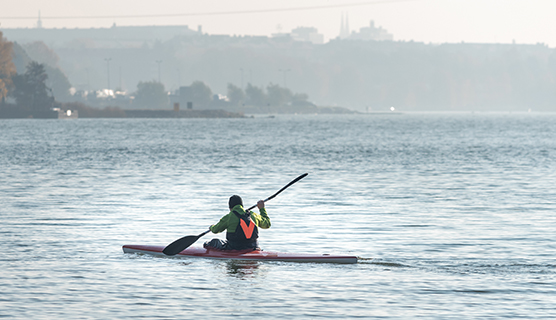Press release 2022-06-09 at 13:12

© Adobe Stock
In Finnish lakes and sea areas, no significant cyanobacterial observations have been made so far. The cool weather in early summer has not been conducive to the development of cyanobacterial blooms. In places, there may be yellowish pollen in lakes or in the sea that looks deceptively like cyanobacteria. The Finnish Environment Institute reports on the national cyanobacterial situation every week until the end of August.
More in Finnish
SYKE observes the cyanobacteria occurrence as part of the monitoring of the state of the environment
The national cyanobacterial monitoring is carried out as part of the monitoring of the state of the environment in cooperation with the Centres for Economic Development, Transport and the Environment (ELY Centres), municipal environmental and health authorities and the Finnish Environment Institute (SYKE). Finnish Rotary Clubs are also actively involved in nationwide cyanobacterial monitoring.
Information on the cyanobacterial situation in the open sea areas is mainly obtained from satellite images, but also from the Finnish Border Guard, the marine research vessel Aranda, the optical device located at the Utö Atmospheric and Marine Research Station, as well as cruise and merchant ships (MS Finnmaid and MS Silja Serenade) equipped with Alg@line measuring equipment. The drift forecasts for cyanobacterial rafts in open sea areas are prepared in cooperation with the Finnish Meteorological Institute's Maritime Services.
The cyanobacterial monitoring is based on the monitoring of cyanobacterial deposits in surface water, and the intention is to provide an overview of the cyanobacterial situation in different water bodies. The monitoring includes about 400 permanent observation sites across the country on inland and coastal waters and in the archipelago.
SYKE reports on the national cyanobacterial situation on a weekly basis every Thursday from the beginning of June until the end of August. The weekly algal reporting on the national cyanobacterial monitoring was launched in 1998.
Several compounds produced by cyanobacteria can cause health hazards
According to the Finnish Institute for Health and Welfare (THL), cyanobacterial occurrences can cause health hazards. Cyanobacteria produce a number of different compounds that can cause symptoms. Some cyanobacteria can produce liver or nerve toxins, but most of the symptoms experienced by swimmers may also be due to other compounds.
Small children and pets should particularly be kept out of water rich with cyanobacteria. Water with cyanobacteria should not be used in a sauna or as washing or irrigation water. If you suspect a poisoning, seek medical advice or take the pet to a veterinarian. If necessary, the Poison Information Centre will provide additional instructions.
The municipal health authorities monitor the cyanobacterial situation on beaches.
Report your cyanobacterial observations to the Järvi-meriwiki (Lake and sea wiki)
In Järvi-meriwiki, maintained by the Finnish Environment Institute, you can establish your own observation site and share cyanobacterial observations or make individual observations when moving around waterways. You can also report observations via the smartphone-friendly Havaintolähetti website. The reported observations are shown on the national cyanobacterial observation map, and they support the national algal situation assessment. Observations about the absence of cyanobacteria are also important.
Järvi-meriwiki is an online service produced in collaboration with authorities and citizens. The service provides basic information on all lakes larger than one hectare as well as different areas of the Baltic Sea. Users can share, for example, photos and other observations on the service.
Municipalities and cities monitor the cyanobacterial situation on the beaches, so it is advisable to report rich cyanobacterial occurrences on beaches to the health authorities of the municipality in question.
Cyanobacterial observations also in the Itämeri.fi and vesi.fi services
The cyanobacterial maps presented on the websites MarineFinland.fi and Vesi.fi combine the observations reported to the Järvi-meriwiki and from the beaches of the City of Helsinki, as well as the observations based on satellite interpretations made by SYKE during the last three days.
This is how you identify cyanobacteria
A small amount of cyanobacteria in the water appears as green or yellowish particles. Narrow stripes of algae can drift to a beach. In calm weather, a substantial amount of cyanobacteria forms greenish or yellowish algal rafts and piles up in coastal water. In spring, yellowish pollen from coniferous trees may also be present in the water. Unlike cyanobacteria, pollen is found not only on the surface water but also, for example, on piers or yard furniture.
Cyanobacteria dissolve into tiny particles in the water if you touch the algal mass with a stick. If the algae become attached to the stick, they are something other than cyanobacteria. In a water vessel, cyanobacteria rise to the surface as tiny greenish particles within about an hour.
Algae bloom risk analysis
Information about algae situation
Pictures
More information
(Telephone 1.00 - 3.00 pm)
Lakes
-
Senior Research Scientist Laura Härkönen, Suomen ympäristökeskus SYKE, Tel. +358 295 251 009, firstname.lastname@syke.fi
Sea areas
Coastal cyanobacterial observations
- Researcher Heidi Hällfors, Finnish Environment Institute SYKE, Tel. +358 295 251 114, firstname.lastname@syke.fi
Offshore cyanobacterial observations
- Eotuki@syke.fi
-
Reearcher Sakari Väkevä, Finnish Environment Institute SYKE, Tel. +358 295 252 088, firstname.lastname@syke.fi (until June 10)
-
Researcher Hanna Alasalmi,Finnish Environment Institute SYKE, Tel. +358 295 251 064,firstname.lastname@syke.fi (from June 13)
State of the Baltic Sea
- Research Professor Maiju Lehtiniemi, Finnish Environment Institute SYKE, Tel. +358 295 251 356, firstname.lastname@syke.fi (until June 10)
-
Tutkija Antti Takolander, Finnish Environment Institute SYKE, Tel. +358 251 206, firstname.lastname@syke.fi (from June 13)
Communications
- Communications Coordinator Saara Sivonen, Finnish Environment Institute SYKE, Tel +358 295 251 082, firstname.lastname@syke.fi